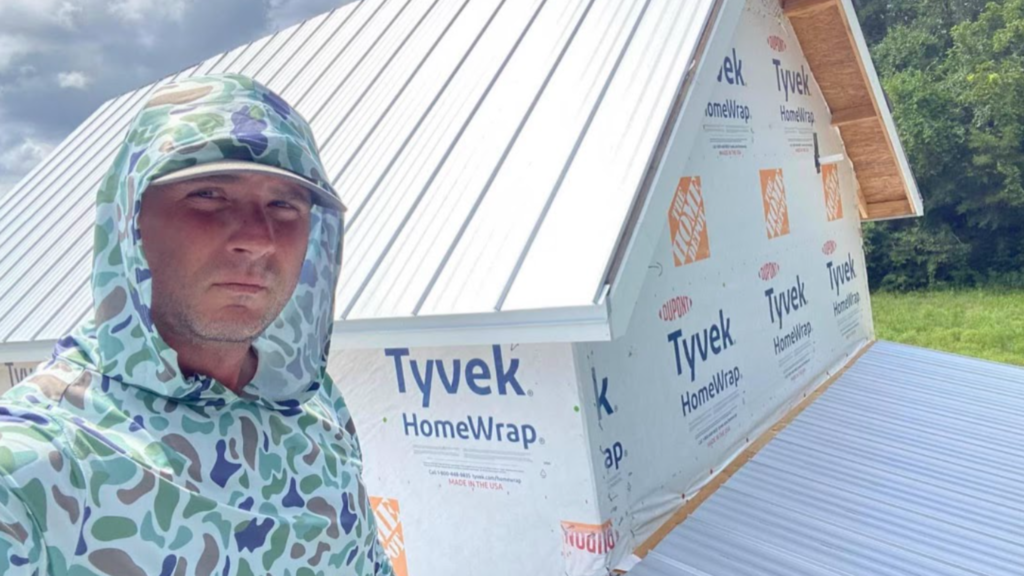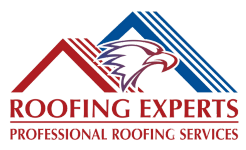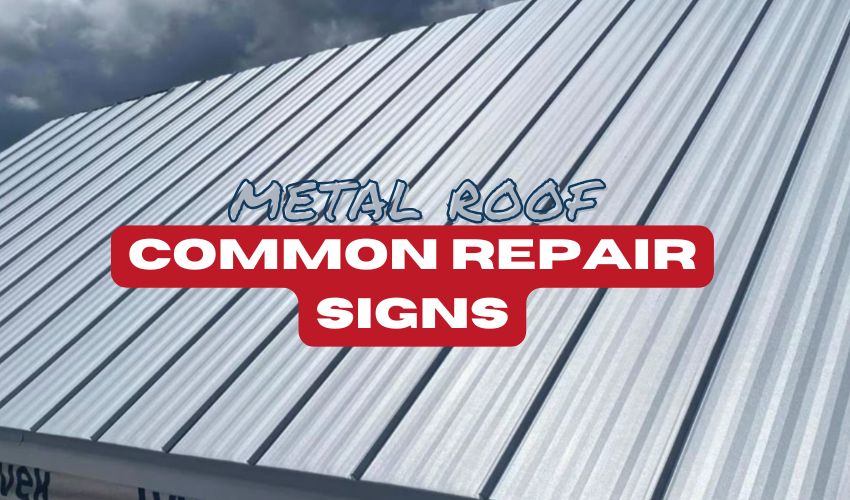Does your Savannah metal roof need repair? When a metal roof needs repairs, there are obvious signs you want to ensure you take notice of!
The National Oceanic and Atmospheric Administration is calling for up to 19 named storms this season—up to five of them major hurricanes. That’s not a distant threat for Savannah homeowners. It’s a flashing warning light aimed straight at your metal roof, attic, and every poorly sealed panel you’ve been meaning to check.
Loose fasteners, cracked sealant, and clogged rain gutters don’t just fail during a storm—they invite disaster. If your roof maintenance routine is “wait and hope,” this is your wake-up call. Here’s how to spot trouble before wind and water find it first.
- Savannah Roofing Experts specialize in roofing, including metal, asphalt shingles, and commercial roofing.
- We can help with roof repairs and roof leak fixes.
- Recgonized as one of the best roofing companies in Savannah.
1. Visible Rust or Corrosion on Panels or Fasteners
Rust doesn’t knock—it creeps in, stains your panels, weakens the seams, and eats away at your roof’s defense. Metal roofs in Savannah face a triple threat: salt-heavy air, humid summers, and sudden storm surges. When rust appears around screws, edges, or anywhere near your chimney or vents, it’s a sign that your protective coating, paint, or sealant has failed.
And don’t ignore the fasteners. When they rust, they loosen. When they loosen, sheet metal panels shift. That shift creates gaps—and gaps welcome water, pests, and deeper decay. Even quality caulk or maintenance routines can’t hold up forever if corrosion takes over.
What to watch for:
- Orange or brown streaks near fasteners, seams, and edges
- Blistering or flaking paint that exposes bare metal
- Loose fasteners or nails backing out of position
- Corrosion near mixed materials, like where metal meets asphalt shingles or flashing
- Rust halos around vents, skylights, or the chimney base
If you see rust, don’t grab a brush and call it fixed. Spotting corrosion early gives you a chance to re-seal, re-coat, and reinforce your roof before water damage spreads—or before pests turn those gaps into entry points.
2. Leaks or Stains in the Attic or Ceiling

That faint yellow stain on your ceiling? It’s not just an eyesore—it’s a warning. Water doesn’t wait for permission. Once it slips past a cracked seam, worn seal, or bad drainage slope, it heads straight for your attic, insulation, and drywall. In Georgia, where storms roll in quickly and intensely, a single unnoticed leak can soon turn into a soaked ceiling, moldy insulation, and a costly insurance claim.
Metal roofs aren’t immune, especially if bitumen seals around vents or flat roof sections have cracked under the heat. And here’s the kicker: some leaks don’t drip directly. They run along beams, hide behind walls, and show up far from the entry point. So by the time you notice, the damage—and the cost—is already growing.
The most common roofing red flags to look for:
- Brown or yellow stains on ceilings or upper walls
- Warped wood or sagging drywall in the attic
- Musty smell even when things look dry
- Pooled water or dark patches near skylights or flat roof sections
- Spike in your energy bills from damp insulation losing effectiveness
A leak isn’t just a drip—it’s a signal your roof is failing somewhere. The smart move? Call a trusted roofer before your next storm does more than test your gutters.
Prevent the damage now, or pay for the rebuild later.
3. Loose or Missing Screws and Fasteners

One missing screw may not sound like a crisis—until it invites water into your attic, bends your metal roof, and sends your utility bill soaring. Every fastener on your roof plays a role in holding panels tight and keeping the system waterproofed. In Savannah’s heat and humidity, those fasteners expand, contract, and loosen over time—especially after storms or poor sealant jobs.
Even a hairline gap created by a missing screw can compromise your flashing, warp your rain gutter, or let water creep behind seams. Over time, that intrusion hits your insulation, affects your home’s energy efficiency, and shows up as a rising cost on your monthly bills. And if water tracks to a window or siding joint, the damage spreads even faster.
What to check during a metal roofing inspection:
- Lifted or uneven metal panels—a sign screws are loose underneath
- Shiny spots or rust rings where fasteners used to be
- Wire or cable movement along the roofline (a clue something’s shifted)
- Missing or detached flashing around vents, skylights, or chimneys
- Water stains or drips near eaves, gutters, or windows
Loose fasteners may look harmless from the ground, but they turn your roof into a shaky system that can’t stand up to Savannah’s storms. A fast, focused inspection now will cost far less than the repairs needed after the next downpour.
4. Warping or Buckling Panels
A warped panel isn’t just ugly—it’s a structural red flag. When your metal roof starts to buckle, it breaks the uniform seal that keeps water, wind, and debris out. That subtle rise or twist in the panel could be the early stage of major water damage, especially if it’s pulling at the seams or lifting around the fasteners.
Improper metal roof installation, poor ventilation, or trapped moisture beneath the panels are all usual suspects. Even rapid temperature swings or repeated hail impacts can cause expansion and contraction that buckle the panel. And once warping sets in, it’s not just the roof at risk. Water can slip into the underlayment, rot structural wood, and trigger a costly renovation before the roof reaches even half its life expectancy.
What to look for before it gets worse:
- Wavy or rippled appearance across sheet panels
- Raised seams or corners catching wind or debris
- Coat peeling or cracking—a sign the panel has flexed too much
- Rust forming after damage scrubbed off protective layers
- Exposed fasteners or gaps between panels and flashing
- Use of a wire brush to clean off paint or rust may worsen the damage if not resealed properly
- Steel panels separating from the support or overlaying asphalt shingles
If you see warping, don’t wait to see what happens after the next storm. Fixing one panel is manageable—rebuilding after it fails is a whole other story.
5. Interior Drafts or Temperature Swings
If your living room feels like a freezer in the morning and a sauna by afternoon, your roofing system might be working against you. Drastic indoor temperature swings—especially near ceilings or upper floors—often signal insulation gaps, a failing vapor barrier, or even a hidden metal roof leak.
This isn’t just about comfort. When hot or cold air seeps in through unseen gaps in the roofline, your HVAC system overworks, your energy bills spike, and long-term wear creeps in where you can’t see it. These subtle shifts can be signs that your home’s metal roofing contractor skipped steps, or that wear and tear has compromised seams, insulation, or decking.
Worse, if the leak has reached concrete substructures or support beams, a small repair can snowball into a full renovation or restoration job.
Key warning signs to monitor:
- Rooms with uneven temperatures, even when vents are clear and the HVAC is running
- Drafts near ceiling fixtures or along attic door seams
- Musty smells or condensation in upper rooms
- Sharp spikes in heating or cooling bills with no lifestyle changes
- Increased humidity in closed areas, especially bathrooms or closets
- Visible daylight through attic joints or vent covers
A skilled metal roofing contractor can trace the source of the draft—whether it’s a misaligned panel, bad sealant, or a missed step during installation.
Don’t just patch with foam or call it a fluke. Consistent airflow issues mean something’s leaking heat—or worse, water—and it’s only a matter of time before comfort issues become a costly restoration job.
6. Sagging or Uneven Rooflines

Hopefully, you don’t have a sagging metal roof in Savannah or nearby!
Roofs are meant to be flat or uniformly pitched, not wavy like a bad haircut. If your roofline is dipping, bulging, or looks like it’s holding a secret stash of bricks, there’s likely something wrong underneath.
Sagging doesn’t start with a crash—it begins with slow, silent failure: trapped moisture, weak trusses, or hidden roof leaks that slowly compromise the support system over time.
Even strong metal panels can’t hold their shape forever without a proper structure beneath them. Poor framing, skipped steps in metal roof maintenance, or damage from unskilled roofing contractors can all lead to long-term distortion. And no amount of wire brush cleanup or surface patching will fix what’s sinking beneath. If the structure is shifting, the only way to stop it is to open it up and fix it right, fast.
Tell-tale signs your roof needs immediate help:
- Visible dips between ridges or along roof edges
- Pooling water on a low-pitch metal roof after rain (Commercial roofing usually).
- Interior bowing or cracked drywall near top-floor ceilings
- Doors sticking or windows misaligned, caused by shifting load
- Metal panels separating or stretching unevenly across the frame
- Repeated patchwork repairs in the same spot with no long-term fix
Sagging roofs aren’t a cosmetic problem—they’re a structural alert. A dependable crew offering quality roofing services should bring more than just a ladder and a sales pitch—they need the tools and experience to stop the collapse before it happens.
7. Excessive Noise During Wind or Rain
Some sound is normal on a metal roof—light tapping during rain or the occasional creak when temperatures shift. But when your home starts sounding like a drumline during a thunderstorm or a wind tunnel in a horror movie, it’s time to pay attention. Loud banging, fluttering, or rattling often means something’s come loose—and when fasteners or seams fail, roof leaks usually follow.
A loose panel or failing membrane doesn’t just make noise—it opens your home to wind-driven rain, shifting pressure, and long-term damage. Unlike asphalt shingles, which stay mostly silent, metal roofing reveals its issues audibly. If the sound is new, louder than usual, or only happens in certain conditions, it’s not your imagination—it’s your roof waving a red flag.
Noises that should raise concern:
- Banging or popping sounds during wind gusts indicate loose or lifted panels
- Whistling or air whooshing through a gap—usually a sign of seam failure
- Rattling noises near flashing or ridges
- Change in volume after recent storms or nearby construction
- Creaking followed by dripping—that’s not just weather, it’s a warning
8. Your Metal Roof Is Over 20 Years Old

Whether you have a shingle roof you want to replace or an older metal roof, after age 20, roofs start to decline. While metal is known to last longer as a roofing material, the components of your roof can certainly wear over the years.
Time doesn’t just pass—it wears down every panel, seam, and fastener on your roof. Once your metal roof hits the 20-year mark, it’s officially entered the inspection-or-replace zone. Even if it looks fine from the ground, hidden wear like brittle seals, degraded waterproofing, or microcracks in the coating could be ticking time bombs.
Every season brings its own set of stressors—UV rays, freezing temperatures, high winds, and debris. And while metal roofs are durable, they’re not immortal. Without regular upkeep or a proper roof restoration, even the strongest system can start to sag, leak, or separate under pressure. If your roof hasn’t seen a professional in years, you’re flying blind.
Key age-related risks to look for:
- Discoloration or fading—often signals UV breakdown in the outer layer
- Dried or cracked sealant around joints, skylights, or vents
- Metal fatigue or stress lines along long panels
- Corrosion in screw holes and fastener heads
- Increased interior moisture or mold growth—signs of failed waterproofing
Don’t wait until panels start curling or water finds its way through your attic. A trusted team of roofing experts can assess whether you need routine metal roof repair or a full roof restoration—and they’ll tell you before damage spreads beyond the surface.
Metal Roof Repair Signs Verdict:
When it comes to metal roof repairs in Savannah, Pooler, and Richmond Hill, Savannah Roofing Experts leads the way with unmatched craftsmanship, quick response times, and honest solutions. Whether you’re dealing with leaks, corrosion, or storm damage, our team delivers long-lasting repairs that protect your home and restore peace of mind. Trust the local experts who know metal roofing inside and out.



Comments are closed